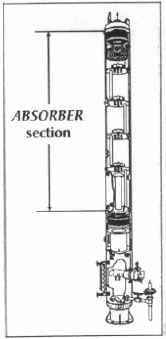نمایش نتیجه 1 تا 10 از 2414 نتیجه یافت شده برای ls:
n: the US Department of the Interior, Minerals Management Service rules and regulations that must be followed by those who drill and produce oil and gas wells located in the Outer Continental Shelf.
v: to cease producing oil and gas from a well when it becomes unprofitable or to cease further work on a newly drilled well when it proves not to contain profitable quantities of oil or gas. Several steps are involved: part of the casing may be removed and salvaged;one or more cement plugs are placed in the borehole to prevent migration of fluids between the different formations penetrated by the borehole;and the well is abandoned. In most oil-producing states, it is necessary to secure permission from official agencies before a well may be abandoned.
to cease efforts to produce or inject fluids in a wells and to plug the well sufficiently to protect the environment and the ability to redrill and develop other reserves at a later date.
n: a well not in use because it was a dry hole originally, or because it has ceased to produce. Statutes and regulations in many states require the plugging of abandoned wells to prevent the seepage of oil, gas, or water from one stratum of underlying rock to another.
n: Usually refers to a well which has no valuable oil or gas production or a dry hole. In general, it should be packed by cement plug.
چاه متروک
n: the average reservoir pressure at which an amount of gas insufficient to permit continued economic operation of a producing gas well is expelled. abd, abdn abbr: abandoned;used in drilling reports.
The minimum pressure of the reservoir when the wells are abandoned.
فشار ترک
a theory of petroleum generation in which petroleum is thought to have formed from hydrocarbons trapped inside the earth’s crust when the earth was forming. See also Biogenic and Organic theories.
n: pressure exceeding or falling below the pressure to be expected at a given depth. Normal pressure increases approximately 0.465 pow1ds per square inch per foot of depth or 10.5 kilopascals per metre of depth. Thus, normal pressure at 1,000 feet is 465 pounds per square inch;at 1,000 metres it is 10,500 kilopascals. See pressure gradient.
n: A formation pressure that deviates from the normal formation fluid hydrostatic pressure. Such pressure may be classified as "subnormal" (lower than normal) or "overpressured" (higher than normal).
n: the theory that minerals such as oil and gas are fully owned in place before they are extracted and reduced to possession. Despite this theory, title to oil and gas may be lost by legitimate drainage and by the rule of capture. Also called ownership in place. See rule of capture.
n: total pressure measured from an absolute vacuum. It equals the sum of the gauge pressure and the atmospheric pressure. Expressed in pounds per square inch.
the reading of gauge pressure plus the atmospheric pressure.
فشار مطلق
n: see absorption oil.
n: A material that can absorb other materials. There are a lot of
جاذب عامل جذب کننده
n: 1. A vertical, cylindrical vessel that recovers heavier hydorcarbons from a mixture of predominantly lighter hydrocarbons. Also called absorption tower. 2. A vessel in which gas is dehydrated by being bubbled through glycol. See absorb.
n: It refers to the row tube holding thezinky
material during the analysis of drilling fluid. Used to survey the content
of H2S.
a vertical, cylindrical vessel that recovers heavier (longer carbon chain) hydrocarbons from a mixture of lighter hydrocarbons.
ظرف جذب





